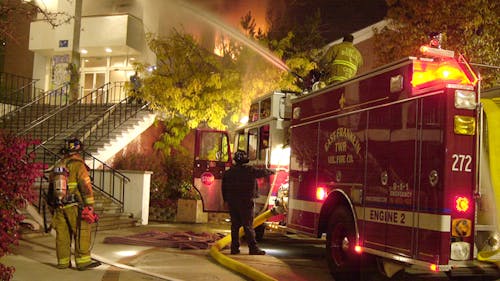Only 65 percent New Jerseyans own fire safety devices

Thousands of Americans die each year from fire-related injuries, and hundreds more perish from carbon monoxide poisoning.
Despite this, only 65 percent of New Jersey homeowners reported having a smoke detector, a carbon monoxide detector and a fire extinguisher, according to a recent Rutgers-Eagleton Public Heath series poll.
According to the poll, 86 percent of New Jersey residents own a carbon monoxide detector, 98 percent have a smoke detector and 75 percent own a fire extinguisher in their home.
Poll director David Redlawsk and his team called 871 New Jersey homes from July 28 to Aug. 5 using random dial and asked if the resident owned the three most important fire-preventive devices.
Redlawsk stressed the importance of having all three fire safety devices because they each serve different purposes.
“Smoke detectors detect fire of course, but don’t detect carbon monoxide. Having a fire extinguisher gives you opportunity to put out a small fire before it gets bigger,” Redlawsk said.
Students should be aware of this issue just like everyone else because they are also at risk, said William Halperin, chair of the Department of Preventive Medicine and Community Health at New Jersey Medical School who also conducted the poll.
Education seems to be the biggest issue when it comes to fire and personal safety, Halperin said.
“For example, I routinely ask my medical students what the source of their hot water is. Is it gas, is it electric, what is it? And a lot of people just don’t know,” he said.
Everyone should be aware of who is responsible for meeting the safety requirements of a building, Halperin said, because it varies.
In residence halls, the University is responsible for installing the proper devices. In rental houses and apartments, landlords are in charge, he said.
“There are people [landlords] who are professional about this, and people who just have extra space to rent out and don’t even know the hazards,” Halperin said.
Overall, Halperin values the findings because of their usefulness in determining how safe homes really are. He was especially pleased to see the high rates of smoke detectors in homes, though disappointed to see the lower rates of carbon monoxide detectors and fire extinguishers.
“Bottom line is, essentially 100 percent of people need access to these devices, and we’re not there yet,” Halperin said.
The fact that virtually every home has a smoke detector suggests that this has become a standard for households, Redlawsk said, though he did notice an economic difference in the data.
The poll revealed that New Jersey residents who are better off economically are much more likely to have all three of the devices in their homes than those who are lower on the economic scale, Redlawsk said.
Ruth Mandel, director of the Eagleton Institute of Politics, immediately considered her own life and whether she complied with the fire safety recommendations upon hearing the poll results.
“I know that in my own case, I passed the test with two out of the three. I’m about to send [the poll] information to my adult daughter and her family because I would like to make sure they have all three,” Mandel said.
Mandel hopes that individuals will also see the statistics and take the opportunity to reflect on whether they have taken the right precautions so far and if not, how they can prepare to take the next step in their personal safety lives.
“No matter where you live, having smoke detectors, carbon monoxide detectors and fire extinguishers is really important,” Redlawsk said.



